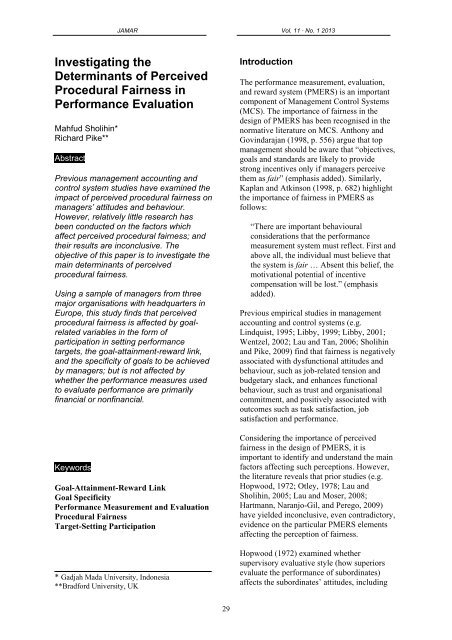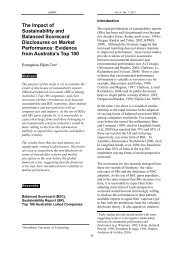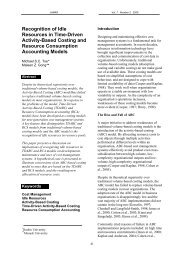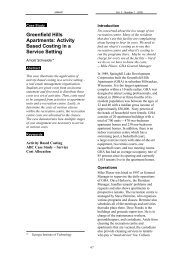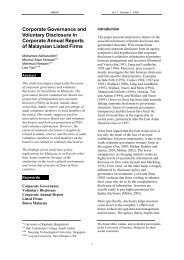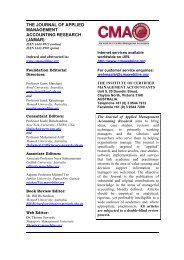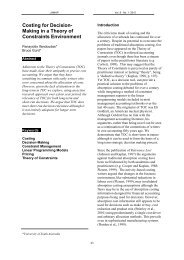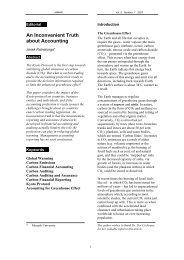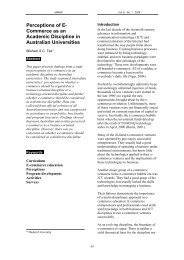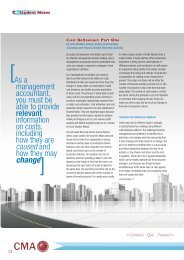Investigating the Determinants of Perceived Procedural Fairness in ...
Investigating the Determinants of Perceived Procedural Fairness in ...
Investigating the Determinants of Perceived Procedural Fairness in ...
- No tags were found...
You also want an ePaper? Increase the reach of your titles
YUMPU automatically turns print PDFs into web optimized ePapers that Google loves.
JAMAR Vol. 11 · No. 1 2013<strong>Investigat<strong>in</strong>g</strong> <strong>the</strong><strong>Determ<strong>in</strong>ants</strong> <strong>of</strong> <strong>Perceived</strong><strong>Procedural</strong> <strong>Fairness</strong> <strong>in</strong>Performance EvaluationMahfud Sholih<strong>in</strong>*Richard Pike**AbstractPrevious management account<strong>in</strong>g andcontrol system studies have exam<strong>in</strong>ed <strong>the</strong>impact <strong>of</strong> perceived procedural fairness onmanagers’ attitudes and behaviour.However, relatively little research hasbeen conducted on <strong>the</strong> factors whichaffect perceived procedural fairness; and<strong>the</strong>ir results are <strong>in</strong>conclusive. Theobjective <strong>of</strong> this paper is to <strong>in</strong>vestigate <strong>the</strong>ma<strong>in</strong> determ<strong>in</strong>ants <strong>of</strong> perceivedprocedural fairness.Us<strong>in</strong>g a sample <strong>of</strong> managers from threemajor organisations with headquarters <strong>in</strong>Europe, this study f<strong>in</strong>ds that perceivedprocedural fairness is affected by goalrelatedvariables <strong>in</strong> <strong>the</strong> form <strong>of</strong>participation <strong>in</strong> sett<strong>in</strong>g performancetargets, <strong>the</strong> goal-atta<strong>in</strong>ment-reward l<strong>in</strong>k,and <strong>the</strong> specificity <strong>of</strong> goals to be achievedby managers; but is not affected bywhe<strong>the</strong>r <strong>the</strong> performance measures usedto evaluate performance are primarilyf<strong>in</strong>ancial or nonf<strong>in</strong>ancial.KeywordsGoal-Atta<strong>in</strong>ment-Reward L<strong>in</strong>kGoal SpecificityPerformance Measurement and Evaluation<strong>Procedural</strong> <strong>Fairness</strong>Target-Sett<strong>in</strong>g Participation* Gadjah Mada University, Indonesia**Bradford University, UKIntroductionThe performance measurement, evaluation,and reward system (PMERS) is an importantcomponent <strong>of</strong> Management Control Systems(MCS). The importance <strong>of</strong> fairness <strong>in</strong> <strong>the</strong>design <strong>of</strong> PMERS has been recognised <strong>in</strong> <strong>the</strong>normative literature on MCS. Anthony andGov<strong>in</strong>darajan (1998, p. 556) argue that topmanagement should be aware that “objectives,goals and standards are likely to providestrong <strong>in</strong>centives only if managers perceive<strong>the</strong>m as fair” (emphasis added). Similarly,Kaplan and Atk<strong>in</strong>son (1998, p. 682) highlight<strong>the</strong> importance <strong>of</strong> fairness <strong>in</strong> PMERS asfollows:“There are important behaviouralconsiderations that <strong>the</strong> performancemeasurement system must reflect. First andabove all, <strong>the</strong> <strong>in</strong>dividual must believe that<strong>the</strong> system is fair … Absent this belief, <strong>the</strong>motivational potential <strong>of</strong> <strong>in</strong>centivecompensation will be lost.” (emphasisadded).Previous empirical studies <strong>in</strong> managementaccount<strong>in</strong>g and control systems (e.g.L<strong>in</strong>dquist, 1995; Libby, 1999; Libby, 2001;Wentzel, 2002; Lau and Tan, 2006; Sholih<strong>in</strong>and Pike, 2009) f<strong>in</strong>d that fairness is negativelyassociated with dysfunctional attitudes andbehaviour, such as job-related tension andbudgetary slack, and enhances functionalbehaviour, such as trust and organisationalcommitment, and positively associated withoutcomes such as task satisfaction, jobsatisfaction and performance.Consider<strong>in</strong>g <strong>the</strong> importance <strong>of</strong> perceivedfairness <strong>in</strong> <strong>the</strong> design <strong>of</strong> PMERS, it isimportant to identify and understand <strong>the</strong> ma<strong>in</strong>factors affect<strong>in</strong>g such perceptions. However,<strong>the</strong> literature reveals that prior studies (e.g.Hopwood, 1972; Otley, 1978; Lau andSholih<strong>in</strong>, 2005; Lau and Moser, 2008;Hartmann, Naranjo-Gil, and Perego, 2009)have yielded <strong>in</strong>conclusive, even contradictory,evidence on <strong>the</strong> particular PMERS elementsaffect<strong>in</strong>g <strong>the</strong> perception <strong>of</strong> fairness.Hopwood (1972) exam<strong>in</strong>ed whe<strong>the</strong>rsupervisory evaluative style (how superiorsevaluate <strong>the</strong> performance <strong>of</strong> subord<strong>in</strong>ates)affects <strong>the</strong> subord<strong>in</strong>ates’ attitudes, <strong>in</strong>clud<strong>in</strong>g29
JAMAR Vol. 11 · No. 1 2013subord<strong>in</strong>ates’ perception <strong>of</strong> fairness <strong>of</strong>performance evaluation processes. In do<strong>in</strong>g so,he constructed three categories <strong>of</strong> performanceevaluation style: Budget Constra<strong>in</strong>ed (BC)style (budgetary <strong>in</strong>formation is used <strong>in</strong> a rigidmanner), Pr<strong>of</strong>it Conscious (PC) style(budgetary <strong>in</strong>formation is used <strong>in</strong> a moreflexible manner, and Non-account<strong>in</strong>g (NA)style (budgetary <strong>in</strong>formation is seen as be<strong>in</strong>g<strong>of</strong> secondary importance). His results<strong>in</strong>dicated that BC style is perceived as less fairthan <strong>the</strong> o<strong>the</strong>r styles. Otley (1978) replicatedHopwood’s (1972) study and found, contraryto Hopwood’s study, that supervisoryevaluative style is not significantly associatedwith perception <strong>of</strong> fairness <strong>of</strong> performanceevaluation processes.Lau and Moser (2008) exam<strong>in</strong>ed <strong>the</strong> effect <strong>of</strong>nonf<strong>in</strong>ancial performance measures onsubord<strong>in</strong>ates’ perception <strong>of</strong> proceduralfairness, argu<strong>in</strong>g that <strong>the</strong>ir use may lead tohigher perceptions <strong>of</strong> fairness <strong>in</strong> performanceevaluation processes (procedural fairness).They also argue that nonf<strong>in</strong>ancial measures aremore consistent with <strong>the</strong> procedural fairnessrules/criteria proposed by Leventhal (1980).Their f<strong>in</strong>d<strong>in</strong>gs show a positive associationbetween nonf<strong>in</strong>ancial measure usage andprocedural fairness.Lau and Sholih<strong>in</strong> (2005) contended and foundthat both nonf<strong>in</strong>ancial and f<strong>in</strong>ancial measuresare positively associated with proceduralfairness, although <strong>the</strong> effect <strong>of</strong> f<strong>in</strong>ancialmeasures on fairness was higher compared tothat <strong>of</strong> nonf<strong>in</strong>ancial measures. This is <strong>in</strong>contrast with Hopwood’s (1972) f<strong>in</strong>d<strong>in</strong>g that<strong>the</strong> effect <strong>of</strong> Non-Account<strong>in</strong>g style on fairnessis significantly higher than that <strong>of</strong> <strong>the</strong> Budget-Constra<strong>in</strong>ed style.A more recent study by Hartman et al. (2009)argues that <strong>the</strong> use <strong>of</strong> subjective performancemeasures is positively associated withprocedural fairness. However, <strong>the</strong>ir f<strong>in</strong>d<strong>in</strong>gsdo not support this argument. Indeed,procedural fairness is associated with <strong>the</strong> use<strong>of</strong> objective performance measures.Hartmann and Slapnicar (2009) argue thatprocedural fairness is not affected byperformance measures or metrics used toevaluate subord<strong>in</strong>ates’ performance but isaffected by <strong>the</strong> degree <strong>of</strong> formality <strong>in</strong> <strong>the</strong> use<strong>of</strong> <strong>the</strong> performance evaluation system. Theirempirical f<strong>in</strong>d<strong>in</strong>gs, however, show nosignificant association between formality andprocedural fairness.The forego<strong>in</strong>g summary <strong>of</strong> relevant priorstudies present a confus<strong>in</strong>g, evencontradictory, picture <strong>of</strong> <strong>the</strong> antecedents <strong>of</strong>procedural fairness <strong>in</strong> PMERS. Given <strong>the</strong>importance <strong>of</strong> this variable, as identifiedearlier by Anthony and Gov<strong>in</strong>darajan (1998)and Kaplan and Atk<strong>in</strong>son (1998), <strong>the</strong> desire toclarify and better understand <strong>the</strong> determ<strong>in</strong>ants<strong>of</strong> perceived procedural fairness providesstrong motivation for this study. In this paper,we <strong>in</strong>vestigate <strong>the</strong> determ<strong>in</strong>ants, orantecedents, <strong>of</strong> procedural fairness perception<strong>in</strong> performance measurement, evaluation andreward systems.This study is different from previous studies,particularly Sholih<strong>in</strong> and Pike (2009), <strong>in</strong> <strong>the</strong>follow<strong>in</strong>g ways. First, whilst Sholih<strong>in</strong> and Pike(2009) <strong>in</strong>vestigates <strong>the</strong> consequences <strong>of</strong>procedural fairness, this study <strong>in</strong>vestigates <strong>the</strong>determ<strong>in</strong>ants <strong>of</strong> procedural fairness. Second,<strong>the</strong> variables exam<strong>in</strong>ed by Sholih<strong>in</strong> and Pike(2009) are procedural fairness, distributivefairness, trust, organisational commitment, jobsatisfaction, and managerial performance. Thevariables exam<strong>in</strong>ed <strong>in</strong> this study areprocedural fairness, participation <strong>in</strong> targetsett<strong>in</strong>g, transparency <strong>of</strong> <strong>the</strong> goal-atta<strong>in</strong>mentrewardl<strong>in</strong>k, goal specificity, f<strong>in</strong>ancialmeasures, and nonf<strong>in</strong>ancial measures. Third,whilst Sholih<strong>in</strong> and Pike (2009) employsorganisational justice <strong>the</strong>ory, <strong>in</strong> this study weuse organisational justice and goal-sett<strong>in</strong>g<strong>the</strong>ories.Draw<strong>in</strong>g on organisational justice literature(e.g. L<strong>in</strong>d and Tyler, 1988; Leventhal, 1980)and goal-sett<strong>in</strong>g <strong>the</strong>ory (Locke and Latham,1990), this study argues that a manager’sperception <strong>of</strong> procedural fairness is <strong>in</strong>fluencedby goal-related variables <strong>in</strong> <strong>the</strong> form <strong>of</strong>participation <strong>in</strong> sett<strong>in</strong>g performance targets,<strong>the</strong> goal-atta<strong>in</strong>ment-reward l<strong>in</strong>k, and <strong>the</strong>specificity <strong>of</strong> goals to be achieved bymanagers; but is not affected by <strong>the</strong> form <strong>of</strong>performance measures used to evaluateperformance, whe<strong>the</strong>r f<strong>in</strong>ancial (objective) ornonf<strong>in</strong>ancial (subjective) measures, as arguedby Lau and Sholih<strong>in</strong> (2005), Lau and Moser(2008), and Hartmann et al., (2009).The proposition that procedural fairness isdeterm<strong>in</strong>ed by <strong>the</strong> degree <strong>of</strong> participation <strong>in</strong>target sett<strong>in</strong>g draws on <strong>the</strong> literature on30
JAMAR Vol. 11 · No. 1 2013procedural justice, which has consistentlyfound that disputants perceive <strong>the</strong> procedure asfair if <strong>the</strong>y have process control (i.e. sufficientopportunity to present <strong>the</strong>ir case), <strong>of</strong>tenreferred to as ‘voice’ (Thibaut and Walker,1975; Folger, 1977; L<strong>in</strong>d and Tyler, 1988). Inaddition, participation is consistent withLeventhal’s (1980) procedural fairness rules.The goal-atta<strong>in</strong>ment-reward l<strong>in</strong>k is proposedas an antecedent <strong>of</strong> procedural fairnessbecause clarity and transparency are outl<strong>in</strong>edby Leventhal (1980) as important components<strong>of</strong> procedural fairness rules. In relation to goalspecificity, Lau and Sholih<strong>in</strong> (2005) argue that<strong>the</strong> adoption <strong>of</strong> specific performancemeasures, are more likely to give rise tospecific goals and targets for employees topursue, than where <strong>the</strong>re are no specificperformance measures for performanceevaluation. The existence <strong>of</strong> specific goals andtargets, <strong>in</strong> turn, is likely to affect employeebehaviour because <strong>the</strong> specificity <strong>of</strong> goalsenhances <strong>the</strong> direction and clarity <strong>of</strong> tasks tobe performed and <strong>the</strong> roles <strong>of</strong> <strong>the</strong> subord<strong>in</strong>ates.The rest <strong>of</strong> <strong>the</strong> paper is organised as follows.Section two will discuss literature review andhypo<strong>the</strong>ses development. Section three,describes <strong>the</strong> research method employed <strong>in</strong>this study. Section four will present f<strong>in</strong>d<strong>in</strong>gsand discussions. This paper will be closed byconclusions, limitation and suggestion forfuture research <strong>in</strong> section five.Literature Review and Hypo<strong>the</strong>sesDevelopmentParticipation and <strong>Procedural</strong> <strong>Fairness</strong>In this study, participation is conceptualised asparticipation <strong>in</strong> sett<strong>in</strong>g performance goals ortargets, which <strong>in</strong>clude f<strong>in</strong>ancial andnonf<strong>in</strong>ancial targets. This is a departure frommost previous account<strong>in</strong>g studies whichconceptualise participation more narrowly asbudgetary participation.<strong>Procedural</strong> fairness can be conceptualised as<strong>the</strong> judgments on <strong>the</strong> fairness <strong>of</strong> social normswhich deal with how decisions are made andhow <strong>in</strong>dividuals are treated by authorities ando<strong>the</strong>r parties (L<strong>in</strong>d and Tyler, 1988). However,s<strong>in</strong>ce this study specifically deals with <strong>the</strong>performance measurement, evaluation andreward system, Folger and Konovsky’s (1989)def<strong>in</strong>ition <strong>of</strong> procedural fairness is adopted,namely, <strong>the</strong> perceived fairness <strong>of</strong> <strong>the</strong> meansand procedures used to determ<strong>in</strong>e <strong>the</strong> amount<strong>of</strong> reward or compensation employees receive,i.e. <strong>the</strong> fairness <strong>of</strong> all aspects <strong>of</strong> <strong>the</strong>organisation’s procedures that are used by <strong>the</strong>superior to evaluate a subord<strong>in</strong>ate’sperformance, to communicate performancefeedback and to determ<strong>in</strong>e <strong>the</strong> subord<strong>in</strong>ate’srewards such as promotion and pay <strong>in</strong>creases.Leventhal (1980) contended that <strong>the</strong>perception <strong>of</strong> procedural fairness will beaffected by six rules: consistency, biassuppression, accuracy, correctability,representativeness, and ethicality <strong>of</strong> <strong>the</strong>procedures. The consistency rule states that tobe fair a procedure must be appliedconsistently across persons and across time.This implies that all parties have <strong>the</strong> samerights under <strong>the</strong> procedures and are treatedsimilarly, and that <strong>the</strong> procedure is enacted <strong>the</strong>same way each time it is used. The biassuppressionrule stipulates that procedures arefair if <strong>the</strong> decision maker does not have avested <strong>in</strong>terest <strong>in</strong> any specific decision, and if<strong>the</strong> decision maker is not <strong>in</strong>fluenced by priorbeliefs. The accuracy rule states that to be fairprocedures should be based on as much goodquality<strong>in</strong>formation and <strong>in</strong>formed op<strong>in</strong>ion aspossible, while <strong>the</strong> correctability rule statesthat opportunities must exist to modify andreverse decisions made. Therepresentativeness rule stipulates that “allphases <strong>of</strong> <strong>the</strong> allocative process must reflect<strong>the</strong> basic concerns, values, and outlooks <strong>of</strong>important subgroups <strong>in</strong> <strong>the</strong> population <strong>of</strong><strong>in</strong>dividuals affected by <strong>the</strong> allocative process”(Leventhal, 1980, pp.44-45). This rule isclosely related to power shar<strong>in</strong>g andparticipatory decision mak<strong>in</strong>g. F<strong>in</strong>ally, <strong>the</strong>ethicality rule states that to be fair, proceduresmust be compatible with fundamental moraland ethical values.Most <strong>of</strong> <strong>the</strong> above requirements for proceduralfairness can be promoted through participation<strong>in</strong> target sett<strong>in</strong>g. For example, participation isconsistent with <strong>the</strong> characteristics <strong>of</strong>representativeness, correctability, accuracy,bias-suppression and ethicality <strong>in</strong> that itpermits subord<strong>in</strong>ates to reflect <strong>the</strong>ir concernsand values, gives opportunity to modifydecisions, can be used as a way <strong>of</strong> shar<strong>in</strong>g<strong>in</strong>formation, provides opportunity forsubord<strong>in</strong>ate managers to correct any<strong>in</strong>appropriate prior beliefs held by <strong>the</strong>irsuperiors, and is consistent with <strong>the</strong> moralvalue that <strong>in</strong>dividuals should have <strong>the</strong>31
JAMAR Vol. 11 · No. 1 2013opportunity to engage <strong>in</strong> sett<strong>in</strong>g goals. It is<strong>the</strong>refore reasonable to propose thatparticipation is positively associated withprocedural fairness. Additionally, L<strong>in</strong>d andTyler (1988, p. 236) argue that “<strong>the</strong>opportunity to exercise voice (participation)constitutes a visible marker <strong>of</strong> groupmembership … mute procedures are seen as… unjust because <strong>the</strong>y appear to deny fullmembership rights to those denied voice”(paren<strong>the</strong>ses added) and “…one <strong>of</strong> <strong>the</strong> mostpotent determ<strong>in</strong>ants <strong>of</strong> <strong>the</strong> procedural fairness<strong>of</strong> a social decision-mak<strong>in</strong>g procedure is <strong>the</strong>extent to which those affected by <strong>the</strong> decisionare allowed to participate <strong>in</strong> <strong>the</strong> decisionmak<strong>in</strong>gprocess through <strong>the</strong> exercise <strong>of</strong>process control or voice” (p. 176). Similarly,Early and Kanfer (1985) argue that s<strong>in</strong>ceparticipation gives opportunity for <strong>in</strong>put, itprovides <strong>the</strong> <strong>in</strong>dividual with perceived masteryor control over a situation; thus participationmay enhance perceived fairness.In a budget<strong>in</strong>g context, Wentzel (2002) studied88 cost centre managers <strong>of</strong> a downsizedhospital <strong>in</strong> <strong>the</strong> US and found that budgetparticipation is positively associated withprocedural fairness. Similar results were foundby Lau and Tan (2006) among managers <strong>of</strong>manufactur<strong>in</strong>g companies <strong>in</strong> S<strong>in</strong>gapore. Thisstudy <strong>the</strong>refore argues that a positiveassociation holds between participation <strong>in</strong>sett<strong>in</strong>g targets and procedural fairness.Ha1: Participation <strong>in</strong> target sett<strong>in</strong>g ispositively associated with procedural fairness.Goal-Atta<strong>in</strong>ment-Reward L<strong>in</strong>k and<strong>Procedural</strong> <strong>Fairness</strong>The management control systems literaturesuggests that <strong>the</strong> performance evaluation andreward system is an important component <strong>of</strong><strong>the</strong> management control system designed tomotivate organisational members to performbetter and <strong>in</strong> accordance with <strong>the</strong>organisation’s objectives (Otley, 1999;Merchant and Van der Stede, 2003).Accord<strong>in</strong>g to Emmanuel et al. (1990) andMerchant and Van der Stede (2003), one <strong>of</strong> <strong>the</strong>pr<strong>in</strong>cipal means <strong>of</strong> motivat<strong>in</strong>g subord<strong>in</strong>atestowards effective performance is to l<strong>in</strong>korganisational rewards to <strong>the</strong> level <strong>of</strong>performance achieved. This implies that <strong>the</strong>l<strong>in</strong>k between <strong>the</strong> achievement <strong>of</strong> goals orperformance targets set and rewards should betransparent. A recent empirical study byKom<strong>in</strong>is and Emmanuel (2007), us<strong>in</strong>g asample <strong>of</strong> middle managers <strong>in</strong> a large UKbasedf<strong>in</strong>ancial <strong>in</strong>stitution, found that <strong>the</strong>effect <strong>of</strong> transparency <strong>in</strong> <strong>the</strong> performancerewardl<strong>in</strong>k on motivation is <strong>in</strong>direct via <strong>the</strong>value <strong>of</strong> extr<strong>in</strong>sic rewards. In o<strong>the</strong>r words,Kom<strong>in</strong>is and Emmanuel’s (2007) studysuggests that <strong>the</strong> effect <strong>of</strong> transparency <strong>of</strong> <strong>the</strong>performance-reward l<strong>in</strong>k on motivation maybe mediated by o<strong>the</strong>r variables, and <strong>in</strong> <strong>the</strong>irstudy this was <strong>the</strong> value <strong>of</strong> extr<strong>in</strong>sic rewards.Draw<strong>in</strong>g on Emmanuel et al.’s (1990) andMerchant and Van der Stede’s (2003)contentions and extend<strong>in</strong>g Kom<strong>in</strong>is andEmmanuel’s (2007) f<strong>in</strong>d<strong>in</strong>gs, this study arguesthat <strong>the</strong> transparency <strong>of</strong> <strong>the</strong> goal-atta<strong>in</strong>mentrewardl<strong>in</strong>k is likely to enhance motivation viaperceived procedural fairness. This is becausea transparent rewards system should beconsistent, unbiased, and accurate, all <strong>of</strong> whichare characteristics <strong>of</strong> procedural fairness(Leventhal, 1980). Therefore, this studyhypo<strong>the</strong>sises that transparency <strong>of</strong> <strong>the</strong> goalatta<strong>in</strong>ment-rewardl<strong>in</strong>k will be positivelyassociated with procedural fairness.Ha2: Transparency <strong>of</strong> <strong>the</strong> goal-atta<strong>in</strong>mentrewardl<strong>in</strong>k will be positively associated withprocedural fairness.Goal Specificity and <strong>Procedural</strong> <strong>Fairness</strong>Goal specificity refers to “<strong>the</strong> extent to which<strong>the</strong> goals are clearly def<strong>in</strong>ed by a supervisor”(Fang et al., 2005). In <strong>the</strong> context <strong>of</strong>performance measurement, evaluation andreward systems <strong>the</strong> goals can be f<strong>in</strong>ancial ornonf<strong>in</strong>ancial. Organisations which develop andadopt specific performance measures, whe<strong>the</strong>rf<strong>in</strong>ancial or nonf<strong>in</strong>ancial, for performanceevaluation are more likely to develop specificgoals and targets for employees to pursue,than are organisations which have no specificperformance measures for performanceevaluation. Fur<strong>the</strong>r, <strong>the</strong> existence <strong>of</strong> prespecifiedgoals is likely to provide clearerunderstand<strong>in</strong>g (goal clarity) for organisationalmembers and <strong>in</strong>dicate how <strong>the</strong>y will beevaluated. In addition, goal specificity andclarity <strong>in</strong>forms employees <strong>of</strong> <strong>the</strong>irresponsibilities and performance targets. Ino<strong>the</strong>r words, <strong>the</strong> existence <strong>of</strong> specific goalswill guide employees <strong>in</strong> decid<strong>in</strong>g where <strong>the</strong>yshould direct <strong>the</strong>ir attention and effort.32
JAMAR Vol. 11 · No. 1 2013In relation to procedural justice, <strong>the</strong> existence<strong>of</strong> goal specificity/clarity is <strong>in</strong> l<strong>in</strong>e with <strong>the</strong>consistency and bias-suppression rules, as aspecific goal is likely to facilitate <strong>the</strong>application <strong>of</strong> procedures consistently acrosstime and persons and be less biased and lesssubjective. In addition, <strong>the</strong> existence <strong>of</strong>specific goals <strong>in</strong>dicates that <strong>the</strong>re is a standardto follow which provides opportunity formanagers to challenge/rebut evaluation. Anempirical study by Greenberg (1986) withsamples <strong>of</strong> middle managers <strong>in</strong> <strong>the</strong> US foundthat <strong>the</strong> ability to rebut/challenge evaluationand consistent application <strong>of</strong> standards areimportant determ<strong>in</strong>ants <strong>of</strong> perceivedprocedural fairness. Hence this studyhypo<strong>the</strong>sises that goal specificity is positivelyassociated with procedural fairness.Ha3: Goal specificity is positively associatedwith procedural fairness.Research MethodData and SampleData used <strong>in</strong> this study were ga<strong>the</strong>red bymeans <strong>of</strong> questionnaire survey <strong>in</strong> three majororganisations, followed by <strong>in</strong>terviews withselected respondents. The organisations wereapproached to participate <strong>in</strong> <strong>the</strong> study because<strong>the</strong>y were lead<strong>in</strong>g companies <strong>in</strong> <strong>the</strong>ir sectorthat had been operat<strong>in</strong>g PMERS for some timewith vary<strong>in</strong>g degrees <strong>of</strong> satisfaction.CO1 is part <strong>of</strong> a highly centralised globalorganisation operat<strong>in</strong>g <strong>in</strong> a specialist, researchdrivensector whose headquarter is <strong>in</strong>Switzerland. Much <strong>of</strong> its recent performancegrowth is through reduc<strong>in</strong>g complexity, us<strong>in</strong>gfewer suppliers and clos<strong>in</strong>g smaller plants.CO2 and CO3 are f<strong>in</strong>ancial servicesorganisations, provid<strong>in</strong>g specialist mortgageand sav<strong>in</strong>gs products through a large number<strong>of</strong> branches. Their corporate <strong>of</strong>fices are both <strong>in</strong><strong>the</strong> UK.For <strong>the</strong> purpose <strong>of</strong> fill<strong>in</strong>g <strong>in</strong> <strong>the</strong> questionnaire,purposive sampl<strong>in</strong>g was employed. Thepr<strong>in</strong>ciple <strong>in</strong> this type <strong>of</strong> sampl<strong>in</strong>g is to get allpossible cases that fit particular criteria(Neuman, 2003). The criteria to be <strong>in</strong>cluded as<strong>the</strong> samples are: 1) managers have beenwork<strong>in</strong>g for <strong>the</strong> organisations for more thanone year; 2) <strong>the</strong>y have been evaluated by <strong>the</strong>irsuperiors; and 3) <strong>the</strong>y have received <strong>the</strong>performance evaluation feedback. Thesecriteria are to ensure that <strong>the</strong> samples are valid.The survey was adm<strong>in</strong>istered as follows.Work<strong>in</strong>g closely with managers from <strong>the</strong> threeorganisations, a prelim<strong>in</strong>ary notification wascirculated encourag<strong>in</strong>g managers to participate<strong>in</strong> <strong>the</strong> survey. After obta<strong>in</strong><strong>in</strong>g seniormanagement permission to conduct <strong>the</strong><strong>in</strong>dependent research study <strong>the</strong> survey<strong>in</strong>strument was distributed to potentialrespondents, toge<strong>the</strong>r with assurance <strong>of</strong>confidentiality. Rem<strong>in</strong>ders were sent one,three and seven weeks after <strong>the</strong> orig<strong>in</strong>almail<strong>in</strong>g. The survey package and rem<strong>in</strong>derletters were sent via e-mail. Respondents couldreturn <strong>the</strong> completed questionnaireselectronically by e-mail or send a hard copyversion by post.The distribution <strong>of</strong> <strong>the</strong> survey <strong>in</strong>struments is asfollows: 102 to CO1, 99 to <strong>the</strong> CO2, and 95 toCO3. Of 296 questionnaires distributed, 174were returned (55 from CO1, 52 from CO2,and 67 from CO3) yield<strong>in</strong>g a total responserate <strong>of</strong> 59 per cent. Careful exam<strong>in</strong>ationrevealed that 9 responses (1 from CO1, 2 fromCO2, and 6 from CO3) were not usable,yield<strong>in</strong>g a total <strong>of</strong> 165 usable responses (56%).Respondents were <strong>in</strong>vited to take part <strong>in</strong>follow-up <strong>in</strong>terviews or group discussions.These <strong>in</strong>terviews sought to better understand<strong>the</strong> results <strong>of</strong> <strong>the</strong> quantitative results and ga<strong>in</strong><strong>in</strong>sight <strong>in</strong>to <strong>the</strong> context <strong>in</strong> which <strong>the</strong> PMERSoperated.Variables and Their MeasurementThe dependent variable <strong>in</strong> this study isperceived procedural fairness and <strong>the</strong><strong>in</strong>dependent variables are participation <strong>in</strong>target sett<strong>in</strong>g, <strong>the</strong> transparency <strong>of</strong> <strong>the</strong> goalatta<strong>in</strong>ment-rewardl<strong>in</strong>k, and goal specificity. Inaddition to <strong>the</strong>se variables, <strong>the</strong> study <strong>in</strong>cluded<strong>the</strong> type <strong>of</strong> performance measures <strong>in</strong> <strong>the</strong> modelas <strong>the</strong> controll<strong>in</strong>g variable. To <strong>in</strong>crease <strong>the</strong>validity <strong>of</strong> <strong>the</strong> measures and to be morecomparable with previous studies, allmeasures were taken from previous literature. 11 All <strong>of</strong> <strong>the</strong> <strong>in</strong>struments were pilot-tested prior to<strong>the</strong> distribution to <strong>the</strong> respondents, on executiveMBA students <strong>of</strong> an UK university.33
JAMAR Vol. 11 · No. 1 2013<strong>Procedural</strong> <strong>Fairness</strong>This variable is measured us<strong>in</strong>g a four-item<strong>in</strong>strument developed by McFarl<strong>in</strong> andSweeney (1992). In management account<strong>in</strong>gstudies it has been used by, for example, Lauand Sholih<strong>in</strong> (2005) and Lau and Tan (2006).Respondents were requested to rate <strong>the</strong>fairness <strong>of</strong> <strong>the</strong> procedures used to evaluate<strong>the</strong>ir performance, to communicateperformance feedback, and to determ<strong>in</strong>e <strong>the</strong>irpay <strong>in</strong>creases and promotion, rang<strong>in</strong>g from 1(very unfair) to 7 (very fair).Participation <strong>in</strong> Target Sett<strong>in</strong>gTo measure this variable, respondents wereasked to <strong>in</strong>dicate <strong>the</strong>ir level <strong>of</strong> agreementus<strong>in</strong>g a 7-po<strong>in</strong>t Likert-type scale, rang<strong>in</strong>g fromstrongly disagree to strongly agree, on a s<strong>in</strong>gleitem <strong>of</strong> “my superior allows me to participate<strong>in</strong> sett<strong>in</strong>g my performance goals/targets”. Thismeasure is adapted from <strong>the</strong> goal-sett<strong>in</strong>gquestionnaire developed by Locke and Latham(1984).Goal-Atta<strong>in</strong>ment-Reward L<strong>in</strong>kTo measure this variable, respondents wereasked to <strong>in</strong>dicate <strong>the</strong>ir level <strong>of</strong> agreementus<strong>in</strong>g a 7-po<strong>in</strong>t Likert-type scale, rang<strong>in</strong>g fromstrongly disagree to strongly agree, on a s<strong>in</strong>gleitem <strong>of</strong> “my rewards are tied to <strong>the</strong>achievement <strong>of</strong> <strong>the</strong> performance goals”. This<strong>in</strong>strument is adapted from Kom<strong>in</strong>is andEmmanuel (2007).Goal SpecificityTo measure goal specificity, three items weretaken from Fang et al. (2005): (1) my superiorspecifically expla<strong>in</strong>ed what my performancegoals are; (2) I have very specific performancegoals <strong>in</strong> my job; and (3) I understand <strong>the</strong> exactlevel <strong>of</strong> my assigned performance goals.Respondents were requested to <strong>in</strong>dicate <strong>the</strong>irlevel <strong>of</strong> agreement to <strong>the</strong> above items, us<strong>in</strong>g aseven-po<strong>in</strong>t Likert-type scale rang<strong>in</strong>g from 1(strongly disagree) to 7 (strongly agree).Performance MeasureThe performance measure is employed as <strong>the</strong>controll<strong>in</strong>g variable. To measure this variable,respondents were requested to <strong>in</strong>dicate howmuch importance <strong>the</strong>y thought <strong>the</strong>irsupervisors attach to certa<strong>in</strong> performancemeasures when evaluat<strong>in</strong>g <strong>the</strong>ir performance,us<strong>in</strong>g a seven-po<strong>in</strong>t Likert scale, anchored 1(no importance) and 7 (always important) with0 if not applicable. 2 The performancecategories used are based on those <strong>of</strong> Ittner etal. (2003), which <strong>the</strong>y consider to be importantdrivers <strong>of</strong> long-term organisational success.The categories are: relations with customers,relations with employees, operationalperformance, product and service quality,alliances with o<strong>the</strong>r organisations, relationswith suppliers, environmental performance,product and service <strong>in</strong>novations, communityperformance, and f<strong>in</strong>ancial performance.F<strong>in</strong>d<strong>in</strong>gs and DiscussionsAs mentioned <strong>in</strong> <strong>the</strong> previous section, a total<strong>of</strong> 296 questionnaires were distributed to threedifferent organisations and 174 were returned.Of <strong>the</strong>se responses, 9 were unusable due to asubstantive part <strong>of</strong> <strong>the</strong> questionnaire be<strong>in</strong>g<strong>in</strong>complete, result<strong>in</strong>g <strong>in</strong> <strong>the</strong> 165 f<strong>in</strong>alresponses used <strong>in</strong> this study. The demographic<strong>in</strong>formation <strong>of</strong> <strong>the</strong> respondents, presented <strong>in</strong>table 1, consists <strong>of</strong> <strong>the</strong> average number <strong>of</strong>employees that respondents directly managed,<strong>the</strong>ir length <strong>of</strong> service (tenure) <strong>in</strong> <strong>the</strong>organisation, tenure <strong>in</strong> <strong>the</strong>ir current position,and <strong>the</strong> length <strong>of</strong> time <strong>the</strong>y have beensupervised by <strong>the</strong>ir current supervisor.The table <strong>in</strong>dicates that respondents from CO1rated all demographic variables more highlythan <strong>the</strong> o<strong>the</strong>r two organisations, with CO2hav<strong>in</strong>g far lower rat<strong>in</strong>gs for length <strong>of</strong> serviceand supervision under current supervisor.However, <strong>of</strong> particular importance to thisstudy is that all respondents had experienced<strong>the</strong> performance review process on at least oneoccasion.To exam<strong>in</strong>e whe<strong>the</strong>r response bias exists, nonresponsebias test was performed. We splitresponses <strong>in</strong>to “early” and “late” responses.Follow<strong>in</strong>g Hall (2008), “Early” is def<strong>in</strong>ed as<strong>the</strong> first 20 percent <strong>of</strong> responses and “late” isdef<strong>in</strong>ed as <strong>the</strong> last 20 percent <strong>of</strong> responses.The responses from those two groups werecompared by runn<strong>in</strong>g t-tests. Table 2 presents<strong>the</strong> results <strong>of</strong> non-response bias tests for eachvariable. The results <strong>in</strong>dicate that <strong>the</strong> majority<strong>of</strong> <strong>the</strong> scores <strong>of</strong> <strong>the</strong> variables do not differbetween <strong>the</strong> early and late responses.2 In <strong>the</strong> analysis, follow<strong>in</strong>g Ittner at al. (2003), 0was converted <strong>in</strong>to 1.34
JAMAR Vol. 11 · No. 1 2013However, <strong>the</strong>re are some differences,particularly for CO2. For example, earlyrespondents <strong>in</strong>dicated that <strong>the</strong>y are evaluatedmore through nonf<strong>in</strong>ancial measures, andperceived that <strong>the</strong> goal-atta<strong>in</strong>ment-reward l<strong>in</strong>kis more transparent and <strong>the</strong> reward distributionis fairer. It is difficult to <strong>of</strong>fer a good reasonfor <strong>the</strong> particular differences but it is sensibleto <strong>in</strong>terpret results <strong>of</strong> <strong>the</strong>se variables withcaution. However, <strong>the</strong> table shows <strong>the</strong>re is nosignificant difference for <strong>the</strong> dependentvariable studied, i.e. procedural fairness, <strong>in</strong>any organisation.Table 1: Demographic Information <strong>of</strong> <strong>the</strong> Respondents Means (with Range Shown <strong>in</strong> Brackets)CO1 CO2 CO3Employees report<strong>in</strong>g to respondent 8(1-60)7(1-60)5(1-21)Tenure <strong>in</strong> organisation 3 16.5(1-36)5.6(1-19)15.4(2-37)Tenure <strong>in</strong> current position 7.8(1-36)2.7(1-8)5.2(1-25)Supervision under current superior 3.7(1-18)2.6(1-8)2.5(1-6)Table 2: Results <strong>of</strong> Non-Response Bias TestsCO1 CO2 CO3VariableMean p- value Mean p- value Mean p- valuedifferencedifferencedifferenceNonf<strong>in</strong>ancial measures 0.574 0.361 0.827 0.004 0.094 0.784F<strong>in</strong>ancial measures 0.200 0.869 1.015 0.156 0.628 0.443Participation 0.500 0.459 0.492 0.161 0.263 0.562Goal-atta<strong>in</strong>ment-reward l<strong>in</strong>k -0.100 0.906 1.121 0.002 0.462 0.317Goal specificity -0.367 0.597 0.005 0.986 0.336 0.297<strong>Procedural</strong> fairness 0.525 0.355 0.466 0.211 0.444 0.340Table 3: Descriptive Statistics <strong>of</strong> Variables StudiedOrganisation/Variable M<strong>in</strong>imum Maximum Mean StandardDeviationCO1Nonf<strong>in</strong>ancial measures 1.78 7.00 4.01 1.33F<strong>in</strong>ancial measures 1.00 7.00 4.88 2.30Participation <strong>in</strong> target sett<strong>in</strong>g 1.00 7.00 4.60 1.64Transparency <strong>of</strong> goal-atta<strong>in</strong>mentrewardl<strong>in</strong>k1.00 7.00 3.82 1.75Goal specificity 1.33 7.00 4.51 1.57<strong>Procedural</strong> fairness 1.75 6.00 3.89 1.23CO2Nonf<strong>in</strong>ancial measures 1.67 6.56 3.83 1.03F<strong>in</strong>ancial measures 1.00 7.00 4.74 1.99Participation <strong>in</strong> target sett<strong>in</strong>g 3.00 7.00 5.43 1.09Transparency <strong>of</strong> goal-atta<strong>in</strong>mentrewardl<strong>in</strong>k3.00 7.00 5.87 0.93Goal specificity 2.00 7.00 5.51 1.01<strong>Procedural</strong> fairness 3.00 6.50 5.16 0.96CO33 Tenure (both <strong>in</strong> <strong>the</strong> organisation and job) and <strong>the</strong> period with <strong>the</strong>ir current superior are given <strong>in</strong> years.35
JAMAR Vol. 11 · No. 1 2013Nonf<strong>in</strong>ancial measures 1.00 7.00 4.95 1.90F<strong>in</strong>ancial measures 1.00 7.00 4.97 1.47Participation <strong>in</strong> target sett<strong>in</strong>g 1.00 7.00 5.02 1.31Transparency <strong>of</strong> goal-atta<strong>in</strong>mentrewardl<strong>in</strong>k1.00 7.00 4.95 1.90Goal specificity 3.33 7.00 5.57 0.83<strong>Procedural</strong> fairness 1.75 6.25 4.52 1.07The descriptive statistics <strong>of</strong> variables studiedare presented <strong>in</strong> table 3. This <strong>in</strong>dicates that for<strong>the</strong> performance measures variable, <strong>the</strong> highestscores both for nonf<strong>in</strong>ancial and f<strong>in</strong>ancialmeasures are found <strong>in</strong> CO3 (for nonf<strong>in</strong>ancialmeasures mean=4.95; SD=1.90 and forf<strong>in</strong>ancial measures mean=4.97; SD=1.47). Theresults suggest that <strong>in</strong> this organisationrespondents perceived that <strong>the</strong>ir superiors relyon both f<strong>in</strong>ancial and nonf<strong>in</strong>ancial measures.The lowest score for nonf<strong>in</strong>ancial measuresand f<strong>in</strong>ancial measures are found <strong>in</strong> <strong>the</strong> CO2(for nonf<strong>in</strong>ancial measures mean=3.83,SD=1.03 and for f<strong>in</strong>ancial measuresmean=4.74, SD=1.99). For <strong>the</strong> dependentvariable, i.e. procedural fairness, <strong>the</strong> lowestscore is found <strong>in</strong> CO1 (mean= 3.89; SD= 1.23)and <strong>the</strong> highest score is found <strong>in</strong> <strong>the</strong> CO2.Interviews with selected respondents fromCO1 established that <strong>the</strong>y viewed <strong>the</strong>procedure as somewhat unfair because <strong>the</strong>performance evaluation system was vague,<strong>in</strong>adequate and <strong>of</strong>fer<strong>in</strong>g little reward foremployees atta<strong>in</strong><strong>in</strong>g performance measures. Inaddition <strong>the</strong>re was little opportunity forpromotion, low or nonexistent pay rises, andlittle <strong>in</strong>centive through f<strong>in</strong>ancial ornonf<strong>in</strong>ancial rewards. This is also evidencedby <strong>the</strong> lower scores for <strong>the</strong> transparency <strong>of</strong> <strong>the</strong>goal-atta<strong>in</strong>ment-reward l<strong>in</strong>k. The follow<strong>in</strong>gcomments ga<strong>the</strong>red from CO1 managersre<strong>in</strong>force this:“… Yearly appraisal is merely formality”(market<strong>in</strong>g managers).“Performance evaluation is <strong>in</strong>adequateand vague...at present <strong>the</strong> appraisal systemis <strong>in</strong>formal and not enforced…<strong>in</strong>novationand creativity are not be<strong>in</strong>g rewarded andencouraged…no rewards for meet<strong>in</strong>gperformance target …noth<strong>in</strong>g happenwhe<strong>the</strong>r <strong>the</strong>y (targets) are achieved or not”(R & D manager).“I’m asked to give more effort than o<strong>the</strong>rswho appear to get more reward f<strong>in</strong>anciallyand credit for what <strong>the</strong>y do… (but I’m) notbe<strong>in</strong>g given <strong>the</strong> credit for (my)achievement” (production manager).The highest score <strong>of</strong> procedural fairness isfound <strong>in</strong> CO2. The follow<strong>in</strong>g quote ga<strong>in</strong>edfrom <strong>the</strong> group discussion re<strong>in</strong>forced <strong>the</strong>survey f<strong>in</strong>d<strong>in</strong>gs:“I thought <strong>the</strong> process was fair though I amnot happy with my pay rise but expect thatthis has been affected by <strong>the</strong> credit crunchwhich has impacted on everyone’s pay andbonus”.To test <strong>the</strong> hypo<strong>the</strong>ses, data were analysedus<strong>in</strong>g both multiple regression and PLS. 4 Priorto <strong>the</strong> ma<strong>in</strong> analysis, ANOVA tests betweengroups were performed to see whe<strong>the</strong>r <strong>the</strong>reare any differences among sub-samples. It wasfound that variability <strong>of</strong> variance between <strong>the</strong>groups (i.e. organisations) for proceduralfairness, participation, transparency <strong>of</strong> goalatta<strong>in</strong>ment-rewardl<strong>in</strong>k, and goal specificity issignificant (see table 4). Therefore <strong>in</strong> runn<strong>in</strong>gregression we controlled <strong>the</strong> organisationeffect.In addition to <strong>the</strong> ANOVA test, <strong>the</strong><strong>in</strong>herentassumptions relat<strong>in</strong>g to <strong>the</strong> adequacy<strong>of</strong> regression models - normality,homoscedasticity, multicol<strong>in</strong>earity andl<strong>in</strong>earity - were tested. Normality refers to <strong>the</strong>shape <strong>of</strong> data distribution for a metric variableand its correspondence to <strong>the</strong> normaldistribution. Hair et al. (1998) argue that thisassumption is <strong>the</strong> most fundamentalassumption <strong>in</strong> regression analysis. To assess<strong>the</strong> normality, Cohen and Cohen (1983)recommend an exam<strong>in</strong>ation <strong>of</strong> residual scatter4The regression was executed us<strong>in</strong>g an OLSapproach with SPSS s<strong>of</strong>tware and <strong>the</strong>n verifiedus<strong>in</strong>g PLS with PLS Graph 3 s<strong>of</strong>tware.36
JAMAR Vol. 11 · No. 1 2013plots <strong>of</strong> <strong>the</strong> dependent and <strong>in</strong>dependentvariables. The results <strong>of</strong> <strong>the</strong> test <strong>in</strong>dicate that<strong>the</strong> normal probability plots <strong>of</strong> <strong>the</strong> residuals <strong>of</strong><strong>the</strong> regression models used <strong>in</strong> this study arescattered along a relatively straight l<strong>in</strong>e. Thismeans that <strong>the</strong> residuals are normallydistributed and thus, <strong>the</strong> normality assumptionis met.With homoscedasticity, it is assumed thatdependent variables exhibit constant varianceacross <strong>the</strong> range <strong>of</strong> <strong>in</strong>dependent variables(Hair et al., 1998). This assumption can betested by plott<strong>in</strong>g <strong>the</strong> residuals aga<strong>in</strong>st <strong>the</strong>predicted values (Cohen and Cohen, 1983;Hair et al., 1998). The homoscedasticityassumption is not violated when <strong>the</strong> plots <strong>of</strong><strong>the</strong> residuals aga<strong>in</strong>st <strong>the</strong> correspond<strong>in</strong>g fitted(predicted) values for <strong>the</strong> models show that allplots are scattered randomly betweenapproximately equal horizontal bands with nodiscernible patterns or systematic variations.The results <strong>in</strong>dicate that <strong>the</strong> homoscedasticityassumption is not violated.Ano<strong>the</strong>r assumption tested is multicoll<strong>in</strong>earity.Multicoll<strong>in</strong>earity occurs when <strong>the</strong> correlationsamong variables are so high that certa<strong>in</strong>statistical analysis cannot be performed.Multicoll<strong>in</strong>earity signifies that at least twoseparate variables are measur<strong>in</strong>g <strong>the</strong> sameth<strong>in</strong>g. Some <strong>in</strong>dications <strong>of</strong> multicoll<strong>in</strong>earityare: <strong>the</strong> correlation between <strong>in</strong>dependentvariables be<strong>in</strong>g greater than 0.85 (Kl<strong>in</strong>e,1998); <strong>the</strong> tolerance levels for <strong>the</strong> variablesand any value be<strong>in</strong>g very small, less than 0.1;and <strong>the</strong> value <strong>of</strong> variance <strong>in</strong>flation factors(VIF) be<strong>in</strong>g greater than 10 (Kl<strong>in</strong>e, 1998;Pallant, 2005). The regression model showsthat <strong>the</strong> tolerance levels for <strong>the</strong> variables areall above 0.1, and that <strong>the</strong> value <strong>of</strong> variance<strong>in</strong>flation factors (VIF) is less than 10. Hence,<strong>the</strong>re is no multicoll<strong>in</strong>earity problem. Inaddition, none <strong>of</strong> <strong>the</strong> correlations between<strong>in</strong>dependent variables is greater than 0.85.L<strong>in</strong>earity refers to <strong>the</strong> extent to which anychanges <strong>in</strong> dependent variables are associatedwith <strong>the</strong> changes <strong>in</strong> <strong>the</strong> <strong>in</strong>dependent variables.Follow<strong>in</strong>g Cohen and Cohen (1983), scatterplots <strong>of</strong> residuals were exam<strong>in</strong>ed. The result<strong>in</strong>dicates that <strong>the</strong> appropriateness <strong>of</strong> <strong>the</strong> l<strong>in</strong>earmodels is not violated.Table 5 presents <strong>the</strong> results <strong>of</strong> bivariatecorrelation analysis and table 6 presents <strong>the</strong>results <strong>of</strong> regression analysis. Table 5 showsthat participation, reward l<strong>in</strong>k, and goalspecificity are positively associated withprocedural fairness. On <strong>the</strong> o<strong>the</strong>r hand, nei<strong>the</strong>rf<strong>in</strong>ancial nor nonf<strong>in</strong>ancial measures areassociated with procedural fairness. Hence, <strong>the</strong>results provide <strong>in</strong>itial support for <strong>the</strong>hypo<strong>the</strong>ses that procedural fairness is affectedby participation, reward l<strong>in</strong>k, and goalspecificity, but do not provide <strong>in</strong>itial supportfor <strong>the</strong> hypo<strong>the</strong>ses that procedural fairness isaffected by <strong>the</strong> type <strong>of</strong> performance measureused to evaluate <strong>the</strong> respondents’ performance.In addition, <strong>the</strong> table also <strong>in</strong>dicates that allgoal-related attributes (goal sett<strong>in</strong>gparticipation, goal-atta<strong>in</strong>ment-reward l<strong>in</strong>k, andgoal specificity) are correlated significantlywith each o<strong>the</strong>r. The table also reveals thatf<strong>in</strong>ancial performance measures are perceivedto be more specific compared to that <strong>of</strong>nonf<strong>in</strong>ancial measures.Table 6 presents <strong>the</strong> results <strong>of</strong> regressionanalysis with procedural fairness as <strong>the</strong>dependent variable and goal-related attributes(goal-sett<strong>in</strong>g participation, goal-atta<strong>in</strong>mentrewardl<strong>in</strong>k, and goal specificity) as <strong>the</strong><strong>in</strong>dependent variables, controll<strong>in</strong>g forperformance measures (f<strong>in</strong>ancial andnonf<strong>in</strong>ancial) and <strong>the</strong> company. The table<strong>in</strong>dicates that participation, reward l<strong>in</strong>k andgoal specificity significantly affect proceduralfairness, although <strong>the</strong> effect <strong>of</strong> goal specificityis marg<strong>in</strong>ally significant (p
JAMAR Vol. 11 · No. 1 2013Table 4: The Results <strong>of</strong> ANOVA TestsVariable F Sig<strong>Procedural</strong> fairness 17.580 0.000Participation 4.448 0.013Transparency 29.802 0.000Goal specificity 14.042 0.000F<strong>in</strong>ancial measures 0.152 0.859Nonf<strong>in</strong>ancial measures 0.579 0.449Table 5: The Results Of Correlation AnalysisPF Part L<strong>in</strong>k GS FM NM<strong>Procedural</strong> <strong>Fairness</strong> 1(PF)0.447** 0.570** 0.467** 0.059 0.005Participation1(Part)0.433** 0.484** 0.070 0.148Reward l<strong>in</strong>k1(L<strong>in</strong>k)0.515** 0.225** 0.128Goal specificity1(GS)0.191* 0.083F<strong>in</strong>ancial measures1(FM)0.223*Nonf<strong>in</strong>ancial1measures (NM)** Correlation is significant at <strong>the</strong> 0.01 level (2-tailed).* Correlation is significant at <strong>the</strong> 0.05 level (2-tailed).Table 6: The Results Of Regression Analysis Us<strong>in</strong>g OLS Approach.Variables Coefficient Coefficient value p-valueConstant b 0 1.759 .001Participation b 1 .199 .036Transparency l<strong>in</strong>k b 2 .415 .000Goal specificity b 3 .169 .097F<strong>in</strong>ancial measures b 4 -.064 .444Nonf<strong>in</strong>ancial measures b 5 -.077 .349Company b 6 .015 .862Adjusted R 2 = 36.8%F = 10.993; p= 0.000Table 7: The Results <strong>of</strong> Regression Us<strong>in</strong>g PLS Approach (T-Statistics <strong>in</strong> Brackets)VariablePath to<strong>Procedural</strong> fairnessParticipation <strong>in</strong> target sett<strong>in</strong>g 0.191 (2.218)*Goal-atta<strong>in</strong>ment-reward l<strong>in</strong>k 0.374 (4.771)**Goal specificity 0.175 (2.077)*F<strong>in</strong>ancial measures -0.071 (1.214)Nonf<strong>in</strong>ancial measures 0.112 (0.821)Company 0.026 (0.314)R 2 41.4%** Significant at <strong>the</strong> 0.01 level (2-tailed).* Significant at <strong>the</strong> 0.05 level (2-tailed).38
JAMAR Vol. 11 · No. 1 2013Overall, <strong>the</strong> results <strong>of</strong> statistical analysissupport <strong>the</strong> arguments that procedural fairnessis affected by participation <strong>in</strong> target sett<strong>in</strong>g,transparency <strong>of</strong> <strong>the</strong> goal-atta<strong>in</strong>ment-rewardl<strong>in</strong>k, and goal specificity. As argued earlier,<strong>the</strong>se three variables are consistent with <strong>the</strong>justice rules proposed by Leventhal (1980) ascontended <strong>in</strong> this study. However, <strong>the</strong> resultsdo not support <strong>the</strong> argument that <strong>the</strong> use <strong>of</strong>f<strong>in</strong>ancial and nonf<strong>in</strong>ancial measures isassociated with procedural fairness (c.f. Lauand Sholih<strong>in</strong>, 2005; Lau and Moser, 2008).The <strong>in</strong>terview results support <strong>the</strong> abovef<strong>in</strong>d<strong>in</strong>gs. For example, a production managerfrom CO1 emphasised <strong>the</strong> importance <strong>of</strong> goalspecificity as follows:“… well def<strong>in</strong>ed targets help me to getorganised which improves myperformance…if targets are not welldef<strong>in</strong>ed (I am) not able to achieve <strong>the</strong>m”.Ano<strong>the</strong>r manager, a market<strong>in</strong>g manager, from<strong>the</strong> same company said:“…(specific goals) allow me (to be) morefocused on achiev<strong>in</strong>g targets, (to make)more focused effort”.The above two managers argued that specificgoals/targets are important because <strong>the</strong>y help<strong>the</strong>m to achieve better performance. Hence, itis likely that goal specificity is positivelyassociated with procedural fairness because itis <strong>in</strong>strumental <strong>in</strong> achiev<strong>in</strong>g betterperformance (c.f. Locke and Latham, 1990;2002). To some extent, it supports <strong>the</strong><strong>in</strong>strumental approach to procedural fairness,i.e. an <strong>in</strong>dividual prefers fair proceduresbecause it will give <strong>the</strong>m better outcomes(L<strong>in</strong>d and Tyler, 1998). A similar reason israised by a market<strong>in</strong>g manager from CO2:“Specific goals are important to mebecause specific goals motivate me tohigher performance and provide me withrequired focus”.With regard to participation, <strong>the</strong> abovemarket<strong>in</strong>g manager <strong>of</strong>fers reasons why it isimportant:“Participation allows me to give <strong>in</strong>put and…I feel <strong>in</strong>volved <strong>in</strong> bus<strong>in</strong>ess and …I canexpress my op<strong>in</strong>ions and I can <strong>in</strong>fluenceoutcomes”.Likewise, <strong>the</strong> production managers argued:“Participation gives me a betterunderstand<strong>in</strong>g <strong>of</strong> how to achieve targetsand understand why I have to do it … itimproves my motivation …”.However, a health and safety manager saidthat participation was “…just for personalsatisfaction”. Presumably, part <strong>of</strong> <strong>the</strong>satisfaction is an assurance that <strong>the</strong> evaluationprocedures are conducted <strong>in</strong> a fair manner.The above quotes suggest various reasons whymanagers value participation. This isconsistent with previous studies <strong>in</strong>organisational justice on <strong>the</strong> positive effects <strong>of</strong>participative decision mak<strong>in</strong>g on proceduralfairness (see Greenberg and Folger 1983; Biesand Shapiro 1988; Magner et al. 1992). Ehlenand Welker (1996) identified whyparticipation affects <strong>the</strong> perception <strong>of</strong> fairness.They are: (1) participation serves to enhance aperception <strong>of</strong> <strong>the</strong> s<strong>in</strong>cerity <strong>of</strong> <strong>the</strong> positiontaken by a decision maker; (2) participationmay generate a perception <strong>of</strong> enhanceddecision quality; (3) participation sends amessage to participants about how <strong>the</strong>y areperceived by o<strong>the</strong>rs; and (4) people desirecontrol over decision outcomes which affect<strong>the</strong>m, and participation is seen as a way toachieve this control.Conclusion, Limitations andSuggestion for Future ResearchThe objective <strong>of</strong> this study is to <strong>in</strong>vestigate <strong>the</strong>antecedents <strong>of</strong> procedural fairness <strong>in</strong> <strong>the</strong>context <strong>of</strong> PMERS. This study is important asprevious studies <strong>of</strong> fairness with<strong>in</strong> PMERScontext produce <strong>in</strong>conclusive f<strong>in</strong>d<strong>in</strong>gs onfactors affect<strong>in</strong>g fairness perception. Draw<strong>in</strong>gon organisational justice literature and goal<strong>the</strong>ory <strong>the</strong> study argues that perceivedprocedural fairness is affected by goal-relatedvariables, i.e. participation <strong>in</strong> sett<strong>in</strong>gperformance targets, <strong>the</strong> goal-atta<strong>in</strong>mentrewardl<strong>in</strong>k, and <strong>the</strong> specificity <strong>of</strong> goals to beachieved by managers. Us<strong>in</strong>g a questionnairesurvey with samples derived from three pr<strong>of</strong>itorientedorganisations, one manufactur<strong>in</strong>gcompany and two f<strong>in</strong>ancial servicesorganisations, this study f<strong>in</strong>ds that perceivedprocedural fairness is affected by participation<strong>in</strong> sett<strong>in</strong>g performance targets, <strong>the</strong> goalatta<strong>in</strong>ment-rewardl<strong>in</strong>k, and <strong>the</strong> specificity <strong>of</strong>39
JAMAR Vol. 11 · No. 1 2013goals to be achieved by managers.Additionally, <strong>the</strong> study f<strong>in</strong>ds that <strong>the</strong> type <strong>of</strong>performance measures (whe<strong>the</strong>r f<strong>in</strong>ancial ornonf<strong>in</strong>ancial) used to evaluate managers is notassociated with perceived procedural fairness.It would seem that much <strong>of</strong> <strong>the</strong> prioraccount<strong>in</strong>g literature has overemphasised <strong>the</strong>importance that performance measure typesmay have on procedural fairness, whe<strong>the</strong>rbudget constra<strong>in</strong>ed, pr<strong>of</strong>it conscious or nonaccount<strong>in</strong>g,to <strong>the</strong> neglect <strong>of</strong> more criticalvariables.This study contributes to <strong>the</strong> literature <strong>of</strong>procedural fairness <strong>in</strong> <strong>the</strong> context <strong>of</strong> PMERSby provid<strong>in</strong>g empirical evidence on factorswhich <strong>in</strong>fluenced perceived proceduralfairness. Look<strong>in</strong>g at <strong>the</strong> practical implications<strong>of</strong> <strong>the</strong> study, <strong>the</strong> results suggest that superiorsshould focus on goal-related variables, i.e.participation <strong>in</strong> sett<strong>in</strong>g performance targets,<strong>the</strong> goal-atta<strong>in</strong>ment-reward l<strong>in</strong>k, and <strong>the</strong>specificity <strong>of</strong> goals to be achieved bysubord<strong>in</strong>ates <strong>in</strong> design<strong>in</strong>g PMERS ra<strong>the</strong>r thanon <strong>the</strong> types <strong>of</strong> performance measures.The study, however, should be <strong>in</strong>terpretedcautiously for <strong>the</strong> follow<strong>in</strong>g reasons. The firstone is <strong>the</strong> <strong>in</strong>herent limitations associated withsurvey method. Future study should exam<strong>in</strong>e<strong>the</strong> issue us<strong>in</strong>g o<strong>the</strong>r approaches, such asexperimental design. Secondly, this studydraws on managers from just threeorganisations. Future study could exam<strong>in</strong>e <strong>the</strong>model us<strong>in</strong>g samples derived from moreorganisations. Thirdly, some variables weremeasured us<strong>in</strong>g a s<strong>in</strong>gle item. However, tocompensate this we have conducted<strong>in</strong>terviews. Future study could use <strong>the</strong> bettermeasure to study <strong>the</strong> same topic..Notwithstand<strong>in</strong>g <strong>the</strong>se limitations, we believethat this study provides clarity on factorsaffect<strong>in</strong>g perceived procedural fairness.ReferencesAnthony, R. and Gov<strong>in</strong>darajan, V. (1998),Management Control Systems, Irw<strong>in</strong>, Chicago.Bies, R. J. and Shapiro, D. L. (1998), “Voiceand justification: Their <strong>in</strong>fluence onprocedural fairness judgments”, Academy <strong>of</strong>Management Journal, September, 3: pp. 676-685.Cohen, J. and Cohen, P. (1983), AppliedMultiple Regression: Correlation Analysis for<strong>the</strong> Behavioral Sciences, L. ErlbaumAssociates, New Jersey, USA.Earley, P. C. and Kanfer, R. (1985), “The<strong>in</strong>fluence <strong>of</strong> component participation and rolemodels on goal acceptance, goal satisfaction,and performance”, Organizational Behaviorand Human Decision Processes, 36 (3): pp.378-390.Ehlen, C. R. and Welker, R. B. (1996),“<strong>Procedural</strong> fairness <strong>in</strong> <strong>the</strong> peer and qualityreview programs”, Audit<strong>in</strong>g: A Journal <strong>of</strong>Practice & Theory, 15 (1): pp. 38-52.Emmanuel, C. R., Otley, D. T., Merchant, K.A. (1990), Account<strong>in</strong>g for ManagementControl, Chapman and Hall, London, UK.Fang, E., Evans, K. R., Zou, S. (2005), “Themoderat<strong>in</strong>g effect <strong>of</strong> goal-sett<strong>in</strong>gcharacteristics on <strong>the</strong> sales control systems-jobperformance relationship”, Journal <strong>of</strong> Bus<strong>in</strong>essResearch, 58 (9): pp. 1214-1222.Folger, R. (1977), “Distributive andprocedural justice: comb<strong>in</strong>ed impact <strong>of</strong>"voice" and improvement on experienced<strong>in</strong>equity”, Journal <strong>of</strong> Personality and SocialPsychology, 35 (2): pp. 108 - 119.Folger, R. and Konovsky, M. A. (1989),“Effects <strong>of</strong> procedural and distributive justiceon reactions to pay raise decisions”, Academy<strong>of</strong> Management Journal, 32 (1): pp. 115-130.Greenberg, J. (1986), “<strong>Determ<strong>in</strong>ants</strong> <strong>of</strong>perceived fairness <strong>of</strong> performanceevaluations”, Journal <strong>of</strong> Applied Psychology,71 (2): pp. 340-342.Greenberg, J. and Folger, R. (1983),“<strong>Procedural</strong> justice, participation and <strong>the</strong> fairprocess effect <strong>in</strong> groups and organizations”,In: PAULUS, P. (Ed.) Basic Group Process,Spr<strong>in</strong>ger-Verlag, New York, USA.Hair, J. R., Anderson, R. L., Tatham, R.E.W.C. B. (1998), Multivariate Data Analysis:With Read<strong>in</strong>gs, Pearson, New Jersey, USA.Hall, M. (2008), “The effect <strong>of</strong> comprehensiveperformance measurement systems on roleclarity, psychological empowerment andmanagerial performance”, Account<strong>in</strong>g,40
JAMAR Vol. 11 · No. 1 2013Organizations and Society, 33 (2-3): pp. 141-163.Hartmann, F. And Slapnicar, S. (2009), “Howformal performance evaluation affects trustbetween superior and subord<strong>in</strong>ate managers”,Account<strong>in</strong>g, Organizations and Society, 34 (6-7): pp. 722-737.Hartmann, F., Naranjo-Gil, D., and Perego, P.(2009), “The effects <strong>of</strong> leadership styles anduse <strong>of</strong> performance measures on managerialwork-related attitudes”, European Account<strong>in</strong>gReview, 19 (2): pp. 275-310.Hopwood, A. G. (1972), “An empirical study<strong>of</strong> role <strong>of</strong> account<strong>in</strong>g data <strong>in</strong> performanceevaluation”, Journal <strong>of</strong> Account<strong>in</strong>g Research,Supplement (10): pp. 156-182.Ittner, C. D., Larcker, D. F., Randall, T.(2003), “Performance implications <strong>of</strong> strategicperformance measurement <strong>in</strong> f<strong>in</strong>ancialservices firms”, Account<strong>in</strong>g, Organizationsand Society, 28 (7-8): pp. 715-741.Kaplan, R. S. and Atk<strong>in</strong>son, A. A. (1998),Advanced Management Account<strong>in</strong>g, PrenticeHall, New York, USA.Kl<strong>in</strong>e, R. (1998), Pr<strong>in</strong>ciples and Practice <strong>of</strong>Structural Equation Modell<strong>in</strong>g, The GuilfordPress, New York.Kom<strong>in</strong>is, G. and Emmanuel, C. R. (2007),“The expectancy-valence <strong>the</strong>ory revisited:Develop<strong>in</strong>g an extended model <strong>of</strong> managerialmotivation”, Management Account<strong>in</strong>gResearch, 18 (1): pp. 49-75.Lau, C. M. and Moser, A. (2008),“Behavioural effects <strong>of</strong> nonf<strong>in</strong>ancialperformance measures: The role <strong>of</strong> proceduralfairness”, Behavioral Research <strong>in</strong> Account<strong>in</strong>g,20 (2): pp. 55 - 71.Lau, C. M. and Sholih<strong>in</strong>, M. (2005),“F<strong>in</strong>ancial and nonf<strong>in</strong>ancial performancemeasures: How do <strong>the</strong>y affect jobsatisfaction?”, The British Account<strong>in</strong>g Review,37 (4): pp. 389-413.Lau, C. M. and Tan, S. L. C. (2006), “Theeffects <strong>of</strong> procedural fairness and <strong>in</strong>terpersonaltrust on job tension <strong>in</strong> budget<strong>in</strong>g”,Management Account<strong>in</strong>g Research, 17 (2): pp.171-186.Leventhal, G. S. (1980), “What should be donewith equity <strong>the</strong>ory? New approaches to <strong>the</strong>study <strong>of</strong> fairness <strong>in</strong> social relationships”, In:Gergen, K., et al. (Eds.) Social Exchange:Advances <strong>in</strong> Theory and Research, PlenumPress, New York.Libby, T. (1999), “The <strong>in</strong>fluence <strong>of</strong> voice andexplanation on performance <strong>in</strong> a participativebudget<strong>in</strong>g sett<strong>in</strong>g”, Account<strong>in</strong>g, Organizationsand Society, 24 (2): pp. 125-137.Libby, T. (2001), “Referent cognitions andbudgetary fairness: A research note”, Journal<strong>of</strong> Management Account<strong>in</strong>g Research, 13 (1):pp. 91-105.L<strong>in</strong>dquist, T. M. (1995), “<strong>Fairness</strong> asantecedent to participative budget<strong>in</strong>g:Exam<strong>in</strong><strong>in</strong>g <strong>the</strong> effects <strong>of</strong> distributive justice,procedural justice and referent cognitions onsatisfaction and performance”, Journal <strong>of</strong>Management Account<strong>in</strong>g Research, 7 (1): pp.122-147.L<strong>in</strong>d, E. A. and Tyler, T. R. (1988), The SocialPsychology <strong>of</strong> <strong>Procedural</strong> Justice, PlenumPress, New York, USA.Locke, E. A. and Latham, G. P. (1984), GoalSett<strong>in</strong>g: A Motivational Techniques that WorksPrentice-Hall, New Jersey, USA.Locke, E. A. and Latham, G. P. (1990), ATheory <strong>of</strong> Goal Sett<strong>in</strong>g and Task Performance,Prentice-Hall, New Jersey, USA.Locke, E. A. and Latham, G. P. (2002),“Build<strong>in</strong>g a practically useful <strong>the</strong>ory <strong>of</strong> goalsett<strong>in</strong>g and task motivation: A 35-yearodyssey”, American Psychologist, 57 (9): pp.705-717.Magner, N. R., Welker, R. B., Johnson, G. G.(1992), “Test<strong>in</strong>g a model <strong>of</strong> voice, control,procedural justice, and organizationalcommitment with latent variable structuralequation analysis”, The International Joumal<strong>of</strong> Conflict Management, 3 (3): pp. 223-236.McFarl<strong>in</strong>, D. B. and Sweeney, P. D. (1992),“Distributive and procedural justice aspredictors <strong>of</strong> satisfaction with personal andorganizational outcomes”, Academy <strong>of</strong>Management Journal, 35 (3): pp. 626-637.41
JAMAR Vol. 11 · No. 1 2013Merchant, K. A. and Van Der Stede, W. A.(2003), Management Control Systems:Performance Measurement, Evaluation andIncentives, Pearson Education, Essex, UK.Neuman, W. L. (2003), Social ResearchMethods: Qualitative and QuantitativeApproaches, Allyn and Bacon, Boston, USA.Otley, D. T. (1978), “Budget use andmanagerial performance”, Journal <strong>of</strong>Account<strong>in</strong>g Research, 16 (1): pp. 122-149.Otley, D. (1999), “Performance management:a framework for management control systemsresearch”, Management Account<strong>in</strong>g Research,10 (4): pp. 363-382.Pallant, J. (2005), SPSS Survival Manual,Open University Press, Beckshire, UK.Sholih<strong>in</strong>, M and Pike, R. (2009), “<strong>Fairness</strong> <strong>in</strong>performance evaluation and its behaviouralconsequences”, Account<strong>in</strong>g and Bus<strong>in</strong>essResearch, 39 (4): pp. 397-413.Thibaut, J. and Walker, J. (1975), <strong>Procedural</strong>Justice: A Psychological Analysis, John Wiley,New York, USA.Wentzel, K. (2002), “The <strong>in</strong>fluence <strong>of</strong> fairnessperceptions and goal commitment onmanagers’ performance <strong>in</strong> a budget sett<strong>in</strong>g”,Behavioral Research <strong>in</strong> Account<strong>in</strong>g, 14 (1):pp. 247-271.42


